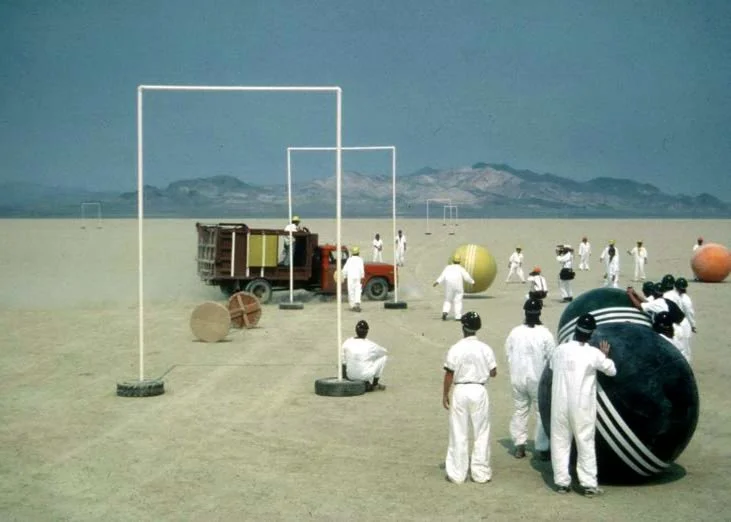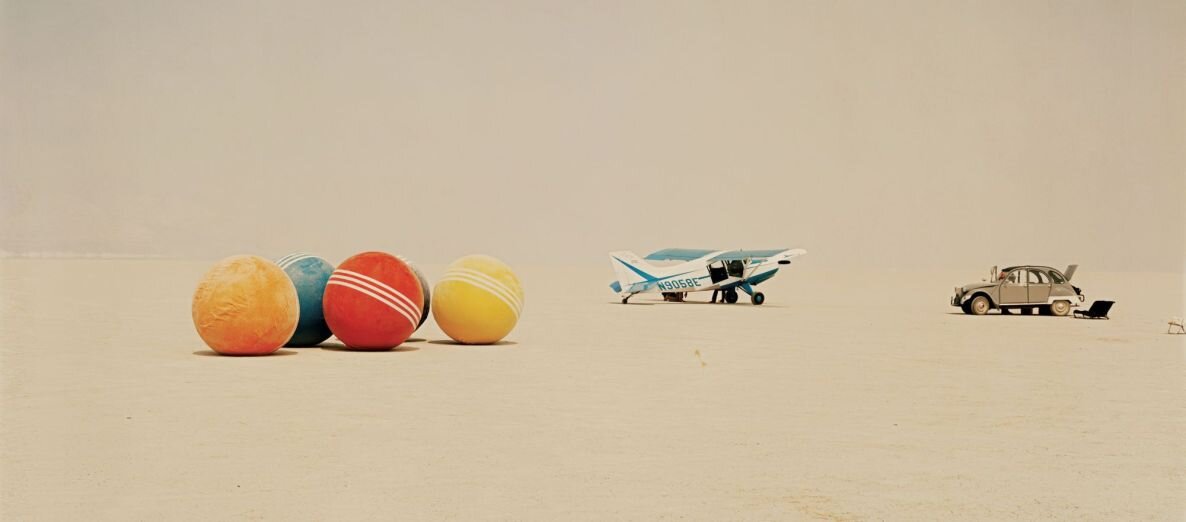WICKED WICKETS OUT WEST
WICKED WICKETS OUT WEST
WHO WOULD BELIEVE CROQUET COULD BE THIS BIG IN THE DESERT?
BY GARY KAMIYA
When people tamper with the scale of a game, they usually make it smaller. Miniature versions are cheaper to produce and often easier to play. If the dimensions of most games were enlarged, participants would likely have difficulty adjusting to unwieldy equipment and Brobdingnagian boundaries. Baseball played on a field with 900-foot fences? The game would require a really lively ball. Basketball with 20-foot-high hoops would undoubtedly be a labored affair, low-scoring and devoid of slam dunks.
This is why Croquet X Machina, a once-in-a-lifetime sporting event that took place in Nevada's Black Rock Desert on the Saturday before Labor Day, 1987, was so remarkable. It was much, much bigger than the original—and it worked.
Croquet X Machina was an enormous motorized six-way croquet match. Beneath the hazy desert sky, on the hard-pan of a great prehistoric lake bed, a motley and dilapidated fleet of trucks smashed brightly colored balls nearly six feet in diameter through 15-foot-high wickets over a course approximately 1,100 feet long. Instead of wielding small wooden mallets, the players used their trucks to advance the balls on long shots. Short shots, rather than being taken with the traditional, genteel between-the-legs stroke, were executed by phalanxes of screaming yeomen wielding a kind of plywood-and-metal battering ram. Possibly for the first time in croquet history, wind was a major factor, as the huge balls showed a disconcerting tendency to become airborne. In the end, though, the game aroused the same emotions as traditional croquet: anger, triumph, humiliation and unseemly gloating.
The Black Rock Desert is a forlorn place, 100 godforsaken miles or so north of Reno. Because Black Rock is so flat, it was chosen in 1983 as the site for an attempt on the world land speed record (which proved to be successful and still stands as the official one-mile record of 633.468 mph, set by Richard Noble). [ED: broken in 1997] What better surface for an oversized croquet match?
The game was played in an area with no plant life. To protect the desert floor, the wickets, made of PVC pipe, were anchored in tires filled with cement instead of being planted in the ground.' The only marks left behind were tire tracks, which vanished with the first rain.
By 11 a.m. on match day, a long line of cars was parked on the hardpan. The game's creator and organizer, a one-eyed, 34-year-old arborist from San Francisco named Marshall Lyons, ran around barking instructions to people who were using compressors to inflate the big canvas-covered rubber balls, which in fact were commercial indoor-exercise balls. Lyons literally dreamed up the idea for Croquet X Machina. After undergoing months of therapy to overcome the psychological effects of a freak auto accident in which he was uninjured but badly shaken, he had a vivid dream of trucks smashing into huge balls on the desert floor.
"It was the idea that I could hit something big, and hit it hard, and nobody would get hurt," says Lyons. "And the ball would roll and roll." He doesn't know quite how this surreal, cathartic image turned into the idea of croquet, but, he says, "when it came, that was it, I just knew it. Huge croquet." Lyons pulled off the event with his friend and partner, John Bogard, who is a potter and lives near Black Rock.
As Lyons nervously ran around shouting instructions, the six teams finished inflating their balls and went out on the course to practice. It resembled the familiar backyard croquet setup. At either end huge stakes rose into the air.
Each team—blue, red, orange, green, black and yellow—had 10 or so members. The players were outfitted in white jumpsuits with color-coded T-shirts and plastic hard hats. They were a mixed lot, from places as far away as Oregon, Maryland and England. Desert rats with leathery faces mingled with yuppies; housewives and postdoctoral researchers argued strategy with gold prospectors. All were invitees to what was actually part of a biennial Labor Day weekend event. Participants, mostly friends of Lyons and Bogard's, had to put up $50 to play; they were also responsible for expenses and transportation to Black Rock.
The motorized "mallets" were diverse as well. The yellow team, which called itself the Existential Sophisticats, rode in a battered, virtually brakeless garbage truck, complete with pitchforks and trash compactor. The blue team, called the Exocets, drove an old flatbed. The black squad used a battered battleship-gray Dodge humpback truck as a mallet. Emblazoned on both doors was BLACK WHOLE.
Lyons met with the team captains to explain the rules. They were basically the same as those for greensward croquet—two free shots for hitting another ball, one free shot for going through a wicket. The infamous "croquet," that sadistic foot-on-your-ball maneuver that makes the game so uniquely malicious, was to be performed by a player smashing his or her body into the enemy ball.
The only major departure from orthodoxy was dictated by the weather. "Due to wind, winter rules are enforced!" Lyons announced. "You are allowed to stop the ball as soon as the judge declares the wind is altering the direction!"
Blue went first. Its ball was set up next to the stake, about 25 yards from the first wicket. The truck, which featured a flaming mallet painted on one side, circled the wicket and came to a stop 100 feet away from the ball. Blue team members stood on either side of the ball, waving their arms. One steadied the ball with his hand. Others waited back by the wicket, prepared to stop the ball from rolling.
The driver revved the engine and popped the clutch. With a roar, the truck shot forward, while team members on the flatbed screamed encouragement. The ball-holder leaped out of the way at the last instant, like a matador. With a satisfying whump, the mallet head—a canvas-covered inner tube mounted on the truck's grill—smashed into the ball. It was a solid hit. The ball rolled fast, hit the left side of the wicket and stopped.
What might be politely termed "gamesmanship" began with this first shot. The blue ballcatchers tried, under pretense of stopping the ball, to edge it closer to the wicket. If the blue team was hoping that its opponents wouldn't notice this unethical move, it was mistaken. Irate shouts went up from the red team. It became clear that no one was going to get away with anything.
The game, although slow, was well played and tense. The red team, leading near the midway point, botched an easy battering-ram shot on blue's ball and fell out of contention. When the game had reached the five-hour mark, it was clear that either blue or yellow would be the winner. Exhaustion set in, but the players staggered cheerfully on, fueled by gritty, competitive endurance and plenty of beer.
With only two wickets to go, yellow seemed to be in command. Its ball was the distance of a Dan Marino bomb from blue's. Unless blue could hit yellow's ball with its next shot, the game would be yellow's to win.
But blue pulled off the shot of the day, a remarkable downwind 75-yard truck smash that rolled slow and true, curving into the yellow ball like a slow-motion pool shot. The yellow team groaned. Blue never looked back. The demoralized yellow team choked on its last chance, a 15-foot battering-ram shot, and blue won. The winners took a raucous victory lap in their flatbed, while the other teams played through.
Lyons had intended Croquet X Machina to be art and sport. And at odd, piercing moments it was indeed both. The cold mathematical precision of the vast course, plunked down in the middle of nowhere, and the gaily painted balls scattered about appeared to be not merely part of a game but also hieroglyphs, clues to a long-forgotten riddle.
The yellow team celebrated its second-place finish with a lap of its own. Before long everyone on the old garbage truck was laughing and trading high fives. As the sun edged toward the horizon, the truck turned away from the course, leaving the huge, still balls sitting on the silent desert floor.
Ya Gotta Regatta, 1989. Image: Richard Misrach/California Sunday


